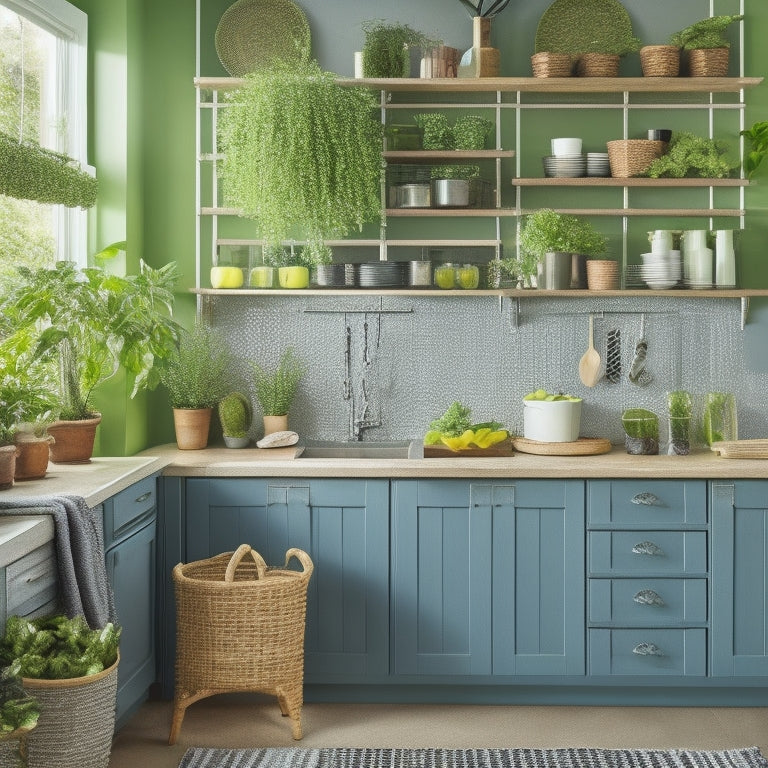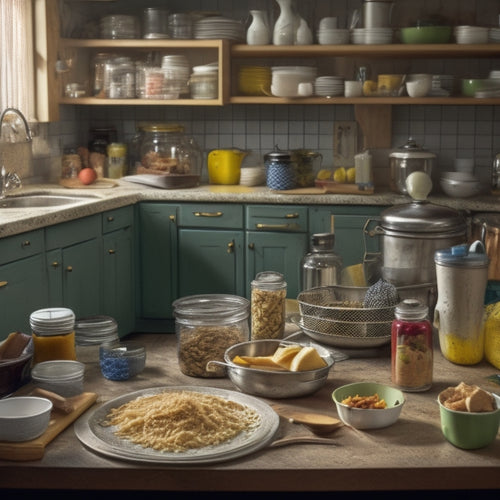
Optimize Your Kitchen Storage for Freshness
Share
Optimizing kitchen storage is essential for maintaining freshness and quality of perishable foods. In the fridge, store ready-to-eat foods on top and middle shelves, and raw meat and fish on bottom shelves. Use recommended containers and maintain temperature control. In the freezer, use airtight containers and a labeling system to guarantee efficient inventory management. In the pantry, store oils and light-sensitive ingredients in airtight containers or dark areas. Finally, tailor storage conditions to each type of fruit and vegetable. By implementing these strategies, you'll be well on your way to maximizing freshness and reducing food waste – and there's even more to explore.
Key Takeaways
• Organize your fridge with ready-to-eat foods on top and middle shelves, and raw meat and fish on bottom shelves for optimal freshness.
• Use airtight containers and freezer bags to store frozen items, and implement a labeling system for inventory management and tracking use-by dates.
• Store fruits and vegetables in ideal conditions, considering ripeness and type, such as refrigerating citrus fruits and berries, and storing stoned fruits at room temperature or in the fridge.
• Designate zones in your pantry for oils, garlic, onions, and potatoes, and use airtight containers or brown paper bags for light-sensitive ingredients.
• Implement a proper pantry system with categorized shelves and baskets, and assign a home for each item to maintain a clutter-free surface and optimize kitchen storage.
Freshness Essentials in the Fridge
Proper storage and organization in the fridge are pivotal for maintaining freshness and preventing the growth of bacteria and odors. Effective fridge organization involves storing ready-to-eat foods on top and middle shelves, while raw meat and fish are placed on the bottom shelves.
Produce placement is also essential, with veggies and fruit stored in the salad drawer after washing. Using recommended food storage containers helps maintain organization and prevents cross-contamination.
Temperature control is crucial, with cheese and fish requiring storage at 5C or below. By following these guidelines, you can ensure your fridge remains a clean and fresh environment for your food, reducing the risk of spoilage and odors.
Smart Freezer Organization Tips
By implementing a few simple strategies, you can maximize your freezer's storage capacity while safeguarding that your frozen foods remain fresh and easily accessible when you need them.
To optimize freezer space, adopt smart freezing techniques such as freezing items in airtight containers or freezer bags to prevent freezer burn and preserve flavor.
Implement a labeling system to identify contents, including the date frozen and use-by dates, making inventory management a breeze. This allows you to quickly locate the items you need and guarantees you use the oldest items first.
Preserving Flavors in the Dark
Most kitchen staples, including oils, garlic, onions, and potatoes, require careful storage in a dark, dry place to preserve their flavors and textures. Light sensitive ingredients can quickly degrade when exposed to direct sunlight, heat, or moisture, resulting in unpleasant flavors and aromas.
Dark pantry solutions, such as airtight containers or brown paper bags, provide the ideal environment for these ingredients. By storing them in a cool, dark place, you can maintain their freshness and flavor.
For example, store oils in sealed bottles away from light and heat, and keep garlic, onions, and potatoes in a dark, dry area. By implementing these simple storage solutions, you can preserve the flavors and textures of your kitchen staples and enjoy a more satisfying cooking experience.
Fruit and Veggie Storage Secrets
In the world of fruit and vegetable storage, understanding the unique requirements of each type is essential to maintaining their freshness and flavor. Countertop fruit bowls and pantry veggie racks can help keep produce organized and visible, ensuring ideal ripeness guidelines are met.
Seasonal produce rotation is key, as certain fruits and vegetables thrive in different conditions. For instance, root vegetables like carrots and beets do well outside the fridge, while leafy greens like kale and spinach last longer in the cold.
Citrus fruits, berries, and cherries benefit from refrigeration, whereas stoned fruits like peaches and plums can be stored at room temperature or in the fridge depending on ripeness. By tailoring storage to each type, you can enjoy your fruits and veggies at their peak.
Common Kitchen Storage Mistakes
Store incorrectly, and your kitchen can quickly become a breeding ground for spoiled food, unpleasant odors, and wasted resources. A common mistake is inadequate pantry organization, leading to expired or spoiled food. Another mistake is improper spice storage, causing flavor loss and contamination.
| Mistake | Solution |
|---|---|
| Cluttered pantry | Implement a proper pantry system with categorized shelves and baskets |
| Inadequate spice storage | Use airtight containers and store spices in a cool, dark place |
| Insufficient fridge organization | Designate zones for raw meat, dairy, and ready-to-eat foods |
| Inadequate fruit and veggie storage | Store produce in ideal conditions, considering ripeness and type |
| Overcrowded countertops | Assign a home for each item and maintain a clutter-free surface |
Frequently Asked Questions
Can I Store Cooked Leftovers Directly in the Fridge?
'Can we really risk foodborne illness by skipping an important step? No, we can't. Cool cooked leftovers quickly before refrigerating them to guarantee food safety; this simple step prevents bacterial growth and keeps your refrigerator storage hygienic.'
How Often Should I Clean My Fridge and Freezer?
To maintain freshness, clean your fridge and freezer every 1-2 weeks, ensuring proper food rotation and ideal temperature settings (3°C-5°C for fridge, -18°C for freezer) to prevent spoilage and bacterial growth.
Are There Any Fruits or Veggies I Can Store at Room Temperature?
When storing fruits and vegetables at room temperature, consider the benefits of ripening and natural sweetness, but be aware of drawbacks like reduced longevity and susceptibility to spoilage, as some fruits, like bananas and apples, fare better than refrigerated counterparts.
Can I Use Plastic Bags to Store Vegetables?
For ideal vegetable storage, avoid using plastic bags, as they can retain moisture and promote spoilage. Instead, opt for breathable alternatives like brown paper bags or mesh bags to maintain freshness and extend shelf life.
Do All Kitchen Utensils and Gadgets Need to Be Stored in a Drawer?
Not all kitchen utensils and gadgets require drawer storage; consider wall-mounted storage, countertop display, hanging racks, or open shelving to keep frequently used items accessible and organized, freeing up drawer space for less-used items.
Related Posts
-

What's Holding You Back From a Clutter-Free Kitchen?
You're struggling to achieve a clutter-free kitchen, and it's not because you're lazy or don't care. You're likely he...
